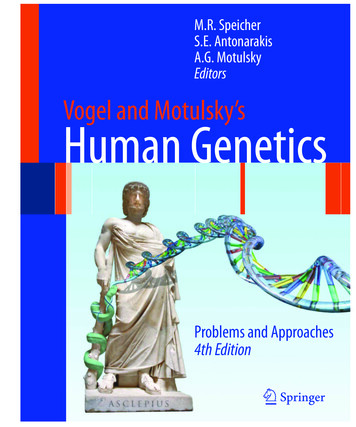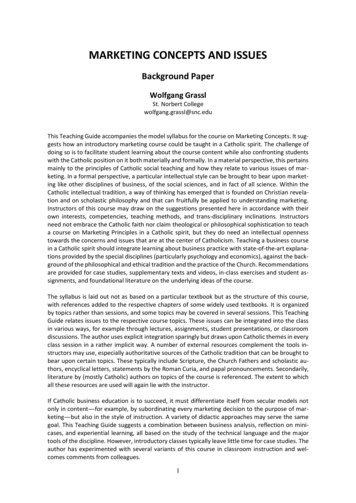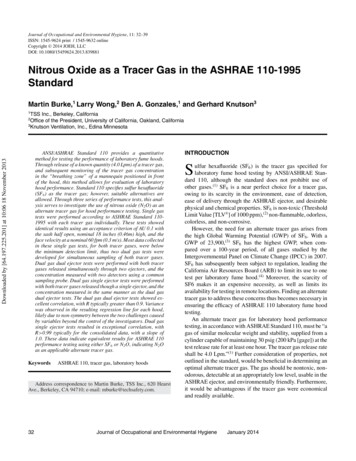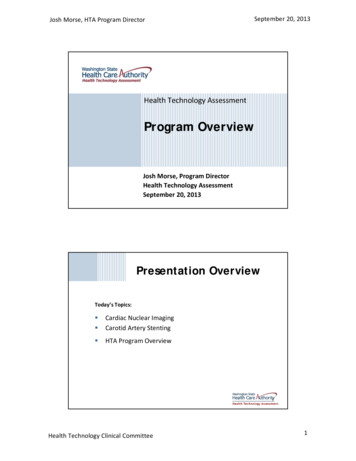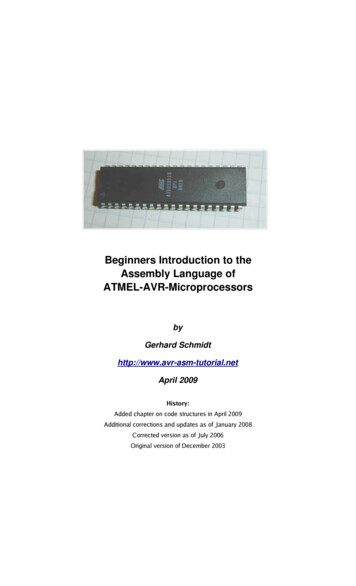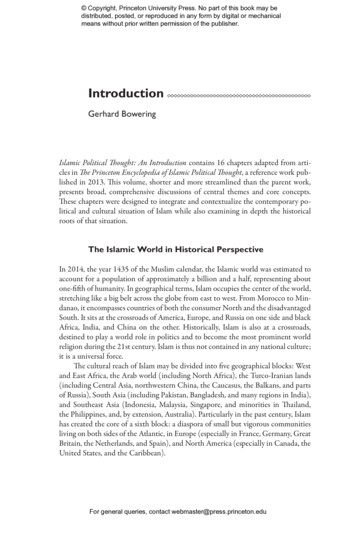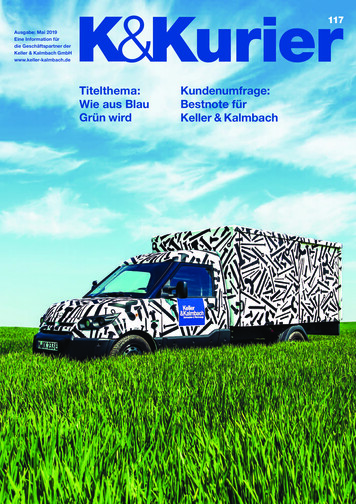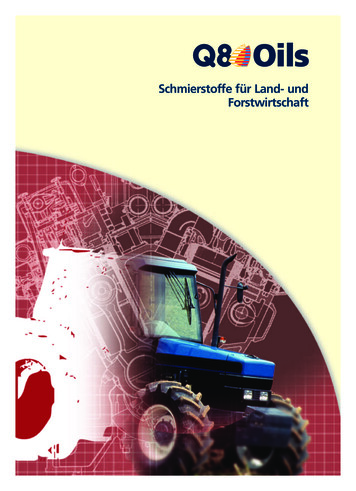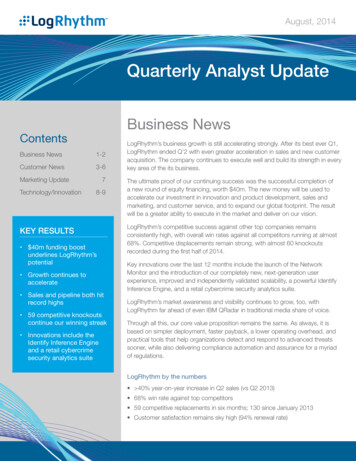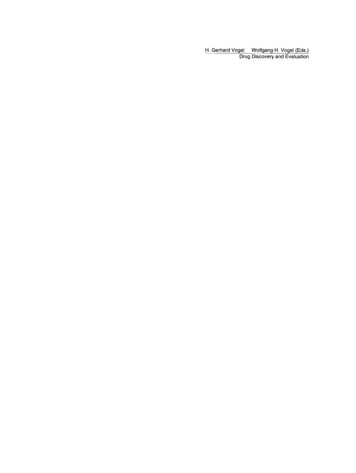
Transcription
H. Gerhard VogelWolfgang H. Vogel (Eds.)Drug Discovery and Evaluation
Springer-Verlag Berlin Heidelberg GmbH
H. Gerhard Vogel Wolfgang H. Vogel(Eds.)Drug Discoveryand EvaluationPharmacological AssaysIncluding a CD-ROMSpringer
Prof. Dr. med. Dr.s.c. H. Gerhard VogelJohann Wolfgang Goethe UniversiUit FrankfurtD-60569 Frankfurt am MainPhilipps UnversWit MarburgD-35037 MarburgGermanyProfessor Dr. Wolfgang H. VogelDepartment of PharmacologyJefferson Medical CollegeThomas Jefferson UniversityPhiladelphia, PA 19107USAISBN 978-3-662-03335-7Library of Congress Cataloging-in-Publication DataVogel, H. Gerhard, 1927Drug discovery and evaluation: pharmacological assays I HansGerhard Vogel, Wolfgang H. Vogel. p. cm.Includes bibliographical references and index.ISBN 978-3-662-03335-7ISBN 978-3-662-03333-3 (eBook)DOI 10.1007/978-3-662-03333-31. Pharmacological, Experimental. I. Vogel, Wolfgang H., 1930- .II. Title [DNLM: I. Drug Design. 2. Drug Evaluation. 3. Drug Screening.QV 744 V878d 1997] RM301.25.V641997 615'.7-dc20DNLM/DLC for Library of CongressThis work is subject to copyright. All rights are reserved, whether the whole or part of thematerial is concerned, specifically the rights of translation, reprinting, reuse of illustrations,recitation, broadcasting, reproduction on microfilms or in any other way, and storage in databanks. Duplication of this publication or parts there of is permitted only under the provisionsof the German Copyright Law of September 9, 1965, in its current version, and permissionfor use must always be obtained from Springer-Verlag. Violations are liable for prosecutionunder the German Copyright Law. Springer-Verlag Berlin Heidelberg 1997Originally published by Springer-Verlag Berlin Heidelberg New York in 1997Softcover reprint of the hardcover 1st edition 1997The use of general descriptive names, registered names, trademarks, etc. in this publicationdoes not imply, even in the absence of a specific statement, that such names are exempt fromthe relevant protective laws and regulations and therefore free for general use.Product liability: The publisher cannot guarantee the accuracy of any information aboutdosage and application thereof contained in this book. In every individual case the user mustcheck such information by consulting the relevant literature.Cover Design: Struve & Partner, HeidelbergTypesetting: Camera ready by Ulrich KunkelSPIN 10500913 27/3137 5 4 3 2 1 0 - Printed on acid free paper -
PrefaceThis book is intended to be an aid for experienced phannacologists as well as fornewcomers in the field of experimental pharmacology. The student in pharmacology, the pharmacist and the medicinal chemist will find a survey of pharmacological assays that can be used for a given indication and for which methods havedemonstrated their relevance. The researchers working in special fields of pharmacology will find assays in other, unfamiliar areas which might help to expand theirown research.Certain therapeutic domains, such as cardiovascular, respiratory and renal disorders, psychiatry and neurology, peripheral nerve function, pain and rheumaticdiseases, metabolic and endocrine diseases including diseases of the gastrointestinal tract, are discussed in this book.Each chapter is divided into pharmacological classes, e.g., anxiolytics, anti-epileptics, neuroleptics, antidepressants, or anti-Parkinson drugs. For each class, invitro methods, tests on isolated organs and in vivo methods are described.For each method the purpose and rationale are given first, followed by a description of the procedure, evaluation of the data, modifications of the method described in the literature, and the relevant references. If possible, a critical assessment of the method based on personal experience is added. The hints for modifications of the method and the extended reference list will be of value for the experienced pharmacologist.A few words for the justification for a book of this kind:In 1959, AJ. Lehman, Director of the Division of Pharmacology at the Foodand Drug Administration, USA, wrote:. Pharmacologists are individualists. Like most scientists they are seldomwilling to copy each other's techniques in detail, and so their methods varyfrom one to the other. Nevertheless. there are basic principles and techniqueswhich must be applied to establish the safety of a new drug.Visitors could also read a sticker in his office:You too can learn pharmacology, in only three lessons: each of them lasting tenyears.Pharmacologists have always used methods from neighboring disciplines; in thepast, e.g. from anatomy, pathology, surgery, zoology and predominantly physiology. Useful methods also came from electrophysiology and the behavioral sciences. Earlier drug discovery was almost exclusively based on animal experiments,clinical observations and serendipity.In recent years, a major input has come from biochemistry. The effect of manydrugs in human therapy could be explained biochemicaly as effects on specific enzymes or receptors. With the detection of more and more receptor SUbtypes, theactivity spectrum of a single compound became more and more complicated. Atpresent, molecular biology provides pharmacologists with human receptors and ion
VIPrefacechannels expressed in mammalian cells in culture. This avoids the apparently existing species differences, but the multitude of natural and perhaps artificial subtypesraises the question of physiological and pathological relevance.The challenge for the pharmacologist always will be to correlate in vitro datawith in vivo findings, bearing in mind the old saying: "In vitro simplicitas, in vivoveritas to. The effects found in tissue cultures are quite often not typical for an intact organism.Pharmacologists, especially in industry, have the task to find new drugs for human therapy by using appropriate models. Pharmacological models have to berelevant, that means they should predict the intended therapeutic indications. Apharmacological model can be considered relevant or correlational, if the effectsobtained correlate with results observed in human therapy.To be relevant or "correlational", a model has to fulfill some basic criteria: First, the model must be sensitive in a dose-dependent fashion to standard compounds that are known to possess the desired therapeutic property. Second, the relative potency of known active agents in the model should becomparable to their relative potency in clinical use. Third, the model should be selective, i.e. the effects of known agents in thistherapeutic indication should be distinguishable from effects of drugs for otherindications. Positive data with a new compound allow the prediction of a therapeutic effect in patients.If new assays are applied to indications for which no effective drug is known,there must be sufficient evidence that this model is relevant for the pathologicalstatus in this indication.The methods presented in this book have been selected according to these criteria.Considerable discussion is going on about the necessity of animal experiments.One has to accept that only the whole animal can reflect the complexity of a human being. Even an experiment with human volunteers is only a model, albeit ahighly relevant one, to investigate therapeutic effects in patients. The degree ofrelevance increases from isolated molecules (e.g. receptors or enzymes) to organelles, to organs up to conscious animals and human volunteers.Without any doubt, animal experiments are necessary for the discovery andevaluation of drugs. However, they should be performed only if they are necessaryand well conceived.In chapter N, regulations existing in various countries concerning the care anduse of laboratory animals are listed. Furthermore, guidelines for anesthesia, bloodcollection and euthanasia in laboratory animals are given. In carrying out animalexperiments, one must adhere strictly to these guidelines. Following these rulesand planing the experiments well, will eliminate or minimize pain and discomfortto the animal. The methods described in this book had the welfare of the animalsas well as the benefit of the procedure for the well-being of mankind in mind.Here, we would like to express our sincere thanks to all colleagues who contributed to this book. Their names and positions are given alphabetically below.Autumn 1996H. Gerhard VogelWolfgang H. Vogel
The EditorsH. Gerhard Vogel received his license in pharmacy at the University of Erlangenand his license in medicine as well as his doctorate in medicine at the University ofTiibingen, Germany. After working in the Institute for Pharmacology and Toxicology at the University of Tiibingen and as a physician in a city hospital, he joinedthe pharmaceutical company, Hoechst AG. First, he worked in general pharmacology, then he became head of endocrinology, head of the department of pharmacology, and finally director of preclinical evaluation and development of Hoechst AG.In these positions, he cooperated with many research laboratories worldwide, especially in the USA, Great Britain, France, Japan, India and China. In 1967, hecompleted his habilitation for pharmacology and toxicology at the Philipps University, Marburg, and was later nominated as honorary professor at the Universityof Marburg and at the Johann Wolfgang Goethe University, Frankfurt, Germany.At both universities, he lectured to students of medicine, dentistry, and humanbiology. He published many original papers, more than 100 on biomechanics andthe biochemistry of connective tissue. In his manifold positions, he obtained athorough insight into the broad spectrum of pharmacological assays to detect andto evaluate potential drugs. This provided him with the expertise to write this booktogether with W. H. Vogel, Jefferson Medical College, Philadelphia, and severalcolleagues from industry and academia.Wolfgang H. Vogel received his Ph. D. in organic chemistry at the Institute ofTechnology in Stuttgart, Germany. During his postdoctoral fellowships in the Departments of Pharmacology at the Colleges of Medicine in Syracuse and Chicago,USA, he acquainted himself with pharmacology and toxicology. He worked inbiochemical pharmacology at the National Institutes of Health in Bethesda for 2years. In 1967, he joined the Department of Pharmacology of Jefferson MedicalCollege of Thomas Jefferson University in Philadelphia. He rose from associateprofessor over full professor to acting chairman of the department. Due to his interest and research in psychiatry, the title of professor of psychiatry and human behavior was awarded to him. In 1994, he was briefly acting chairman of the Instituteof Toxicology at the University of Marburg, Germany. He lectures to medical andgraduate students, residents and physicians during postgraduate seminars and haspublished widely in the field of stress, and the biochemical and genetic basis ofbehavior and addictions. His academic background, combined with the extensiveindustrial experience of H. G. Vogel, has greatly benefitted the completion of thisbook.
List of contributorsAlbus UdoBartlett Robert R.Bickel MartinBrioni, Jorge D.Gogelein HeinzGreger R.Herling Andreas W.Hock Franz JakobHropot MaxHuger Francis P.Jablonka BerndJust MelittaLinz WolfgangMaas JochenMcGaugh James L.Muller GunterRaiss Ruth X.v. Rechenberg W.Rudolphi K.A.Scholkens BernwardSeeger KarlWirth KlausHoechst-Marion-Roussel, Cardiovascular Research,D-65926 FrankfurtHoechst-Marion-Roussel, Immunopharmacology,D-65174 WiesbadenHoechst-Marion-Roussel, Metabolism Research,D-65926 FrankfurtAbbott Laboratories, Neuroscience Research,Abbott Park, USAHoechst-Marion-Roussel, Cardiovascular Research,D-65926 FrankfurtInstitute of Physiology, University of Freiburg,D-79104 FreiburgHoechst-Marion-Roussel, Metabolism Research,D-65926 FrankfurtHoechst-Marion-Roussel, General Pharmacology,D-65926 FrankfurtHoechst-Marion-Roussel, CardiovascularResearch, D-65926 FrankfurtHoechst-Marion-Roussel, Neuroscience Research,Sommerville, NJ, USAHoechst-Marion-Roussel, CardiovascularResearch, D-65926 FrankfurtHoechst-Marion-Roussel, CardiovascularResearch, D-65926 FrankfurtHoechst-Marion-Roussel, CardiovascularResearch, D-65926 FrankfurtHoechst-Marion-Roussel, Pharma Research,D-65926 FrankfurtCenter for Neurobiology of Learning and Memory,University of California at Irvine, Irvine, Ca 92717, USAHoechst-Marion-Roussel, Metabolism Research,D-65926 FrankfurtHoechst-Marion-Roussel, Osteoarthritis Research,Wiesbaden D-65174Hoechst-Marion-Roussel, General Pharmacology,D-65926 FrankfurtHoechst-Marion-Roussel, Cardiovascular Research.D-65926 FrankfurtHoechst-Marion-Roussel, Cardiovascular Research,D-65926 FrankfurtHoechst-Marion-Roussel, Pharma Research,D-65926 FrankfurtHoechst-Marion-Roussel, CardiovascularResearch, D-65926 Frankfurt
ContentsChapter ACardiovascular activity l.13A.1.l.I4A. l.l.I 5A. 1.1.16A.l.l.I6.1A.1.1.16.2A.l.l.I6.3A.1.1.16.4A. 1. 2.4A.I.2.5A.I.2.6A.1.2.7A.I.2.8Cardiovascular analysis . . .In vitro methods . .aj-Adrenoreceptor binding. l:z- Adrenoreceptor binding. . . . . . . . .Imidazoline receptor binding. -Adrenoreceptor binding . . I-Adrenoreceptor binding . 2-Adrenoreceptor binding .Adenosine Al receptor binding .Adenosine A2 receptor binding .Inhibition of adenosine uptake in human erythrocytes .Inhibition of the angiotensin-converting enzyme in vitro . .Angiotensin II receptor binding. . .Renin-inhibitory activity using human kidney reninand a synthetic substrate .PAF binding assay .Endothelin receptor antagonism . . . .Nitric oxide formation by cultured endothelial cells .Inhibition of Na /H exchange .Inhibition of Na /H exchange in thrombocytes .Inhibition of Na /H exchange in cholesterol activated rabbiterythrocytes . .Sodium influx into cultured cardiac myocytes .Inhibition of Na /H exchange into cultured aorticendothelial cells .Inhibition of phosphodiesterase .Stimulation of heart membrane adenyl ate cyclase .Patch clamp technique in isolated cardiac myocytes.Studies in isolated organs .a-Sympatholytic activity in isolated vascular smooth muscle .a-Sympatholytic activity in the isolated guinea pigseminal vesicle .a-Sympatholytic activity in the isolated vas deferens of the rat. .a-Sympatholytic activity in the isolated rat spleen . I-Sympatholytic activity in isolated guinea pig atria . 2-Sympatholytic activity in the isolated tracheal chain .Angiotensin converting enzyme inhibition in the isolatedguinea pig ileum .Vasorelaxing activity of various agents including potassiumchannel openers 3535363738
2A.1.3.3A.1.3.24A.1.3.25A.1.3.26A.1.3.27Isolated arteries with and without endothelium.Bioassay of EDRF release .Isolated guinea pig ureter .Cardiovascular analysis in vivo .Hemodynamic screening in anesthetized rats .Blood pressure in pithed rats .Antihypertensive vasodilator activity in ganglion-blocked,angiotensin II supported rats .Blood pressure in conscious rats (tail cuff method) .Direct measurement of blood pressure in conscious ratswith indwelling catheter .Cardiovascular drug challenging experimentsin anesthetized dogs .Hemodynamic analysis in anaesthetized dogs .Hemodynamic measurements in conscious dogs .Hemodynamic studies in anesthetized monkeys .Measurement of cardiac output and regional blood flowwith microspheres .Carotid artery loop technique .Measurement of heart dimensions in anesthetized dogs .Telemetric monitoring of cardiovascular parameters .Cardiovascular effects after intracerebroventricularadministration .Influence on orthostatic hypotension .Endotoxin induced shock.Hemorrhagic shock .Tourniquet shock .u- and -adrenoreceptors in the mouse iris. .Activity at l- and 2-adrenoreceptors in the rat. . l- and 2-sympatholytic activity in dogs .Intrinsic -sympathomimetic activityin reserpine-pretreated dogs .Cat nictitating membrane preparation(Ganglionic blocking activity) .Angiotensin II antagonism.ACE inhibition measured in vivo in the rat. .Evaluation of renin inhibitors in dogs .Evaluation of renin inhibitors in monkeys ds to induce experimental hypertension .Acute renal hypertension .Chronic renal hypertension in rats .Chronic renal hypertension in dogs .Neurogenic hypertension in dogs .DOCA-saJt induced hypertension in rats .Genetic hypertension in rats .3.2.1Coronary drugs .Isolated organs .Isolated heart according to LANGENDORFF .Coronary artery ligation in isolated working rat heart. .Relaxation of bovine coronary artery .In vivo methods .Isoproterenol induced myocardial necrosis in rats 585960616263646566676869717273
Occlusion of coronary artery in anesthetized dogs .Acute ischemia by injection of microspheres in dogs .Coronary thrombosis in dogs and pigs . . . .Influence on myocardial preconditioning .Ex vivo methods .Plastic casts from coronary vasculature bed .A.4A.4.0.1A.4.1A.4.1.1A.4.2A.4.2.1Calcium uptake inhibiting activity . 96General considerations. 96In vitro methods . 973H-nitrendipine binding in vitro . 97Isolated organs . 100Calcium antagonism on action potential of isolateduinea pig papillary muscle. . . . . . . 100Calcium antagonism in the isolated guinea pig atrium . 100Calcium antagonism in the isolated rabbit aorta . 101Calcium antagonism in the isolated guinea pig pulmonary artery. 102In vivo methods . 103Evaluation of calcium blockers in the pithed rat . ti-arrhythmic activity .General considerations .Aconitine antagonism in rats . . . .Digoxin-induced ventricular arrhythmias in anesthetizedguinea pigs .Strophanthin or ouabain induced arrhythmia .Ventricular fibrillation electrical threshold . .Coronary artery ligation, reperfusion arrhythmiaand infarct size in rats. . . . .Ventricular fibrillation after coronary occlusionand reperfusion in dogs. . . . .Characterization of anti-arrhythmic activity in the isolatedright ventricular guinea pig papillary muscle.Action potential and refractory period in isolatedleft ventricular guinea pig papillary muscle . .116A.6A.6.0.1A.6.0.2A.6.0.3Methods to induce cardiac hypertrophy and insufficiency.Aortic banding in rats.Cardiac insufficiency in guinea pigs .Cardiomyopathic Syrian hamster . ;.11811811 .2A.7.2.3A.7.3A.7.3.lA.7.3.2Positive inotropic activity (cardiac glycosides) .General considerations.In v itro tests. . . . .Ouabain binding. .Influence on Na /K ATP ase .Tests in isolated tissues and organs.Isolated cat papillary muscle . . . .Isolated hamster cardiomyopathic heart. .Potassium loss from the isolated guinea pig heart .In vivo tests .Cardiac toxicity in cats (Hatcher's method) .Decay rate and enteral absorption rate of cardiac glycosides. 0.9104104106107108109109111115
7A.8.2.8A.8.2.9Effects on blood supply and on arterial and venous tonus .Models for stroke and multi-infarct cerebral dysfunction .Cerebral ischemia by carotid artery occlusionin Mongolian gerbils. . .Forebrain ischemia in rats.Hypoxia tolerance test in rats .Middle cerebral artery occlusion in rats .Photochemically induced focal cerebral ischemia in rats .Microdialysis and neuroprotection experimentsafter global ischemia in rats . .Hypoxia! hypoglycemia in hippocampal slices .Measurement of local cerebral blood flowand glucose utilization in rats .Cerebrovascular resistance in anesthetized baboons .Effect on cerebral blood flow in cats (Fluvography) .Effect on cerebral blood flow and in ischemic skeletal musclein rats (Laser-Doppler) .Peripheral blood supply.Perfused hindquarter preparation with sympathetic nervestimulation in rats. . . . . . . .Effect on peripheral blood flow in rats .Effect on peripheral blood flow in anaesthetized dogs.Effect on peripheral blood supply measuredby local oxygen pressure .Effect on mesenteric blood flow in rats . .Effect on pulmonary blood flow .Effect on contractile force of ischemic muscle .Effect on perfusion of rabbit ear (Pissemski method) .Effect on venous tonus in situ in 142143144145146147148149Chapter BActivity on blood constituents. . . 8B.1.0.9B.1.0.1OIn vitro tests. . .Platelet aggregation and deaggregation in platelet rich plasma(BORN method) . .Platelet aggregation after gel filtration .Platelet aggregation in whole blood .Fibrinogen receptor binding .Thrombelastography .P AF antagonism.Flow behavior of erythrocytes .Filtrability of erythrocytes .Erythrocyte aggregation . .Determination of plasma viscosity 2.0.3B.2.0AB.2.0.5B.2.0.6B.2.0.7In vivo or ex vivo tests . . .Reversible intravital aggregation of platelets .Inhibition of experimental thrombocytopenia or leucocytopenia.Inhibition of collagenase-induced thrombocytopenia .Laser induced thrombosis .Caval vein thrombosis or thrombolysis .Inhibition of arterial and venous thrombosis .Arterial bleeding time .
This book is intended to be an aid for experienced phannacologists as well as for newcomers in the field of experimental pharmacology. The student in pharmacol ogy, the pharmacist and the medicinal chemist will find a survey of pharmacologi cal assays that can
